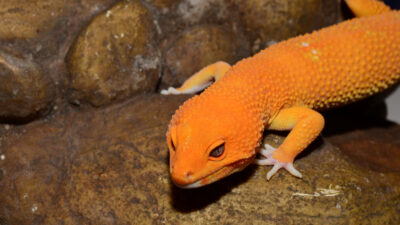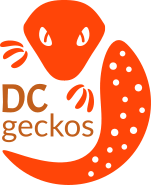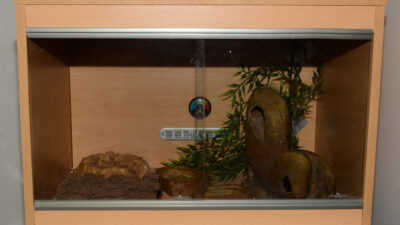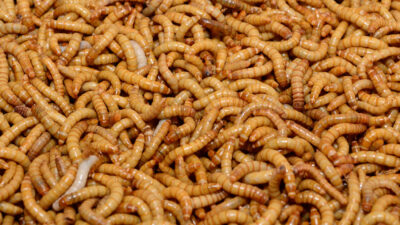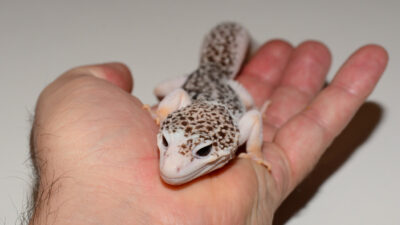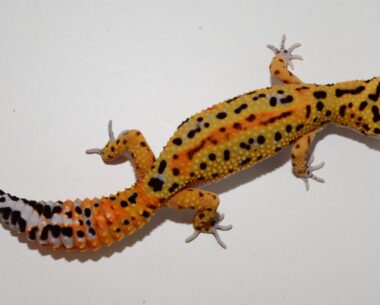Captive Environment
There are many areas in the basic care of leopard geckos so I’ve broken them down into these individual subjects.
COHABITING
Leopard geckos are often kept in a vivarium. I recommend that all geckos should be housed individually as when housed together, one will eventually become dominant and they will fight, with serious injury or even death as a consequence, especially if two males are housed together. My advice is its not worth the risk, house them individually.
SUBSTRATE
This can be a touchy subject with many different opinions about what is best to use. The following is just my opinion and what has and what is currently working for me. Many different loose substrates are commercially available such as sand or cork chips, however these are best avoided due to the risk of impaction if swallowed by your geckos.
For beginners completely new to Leopard Geckos, I have found a good substrate to begin with is linolium, as it presents no risk of impaction to your gecko that you could get with other loose substrates. It is also very easy to keep clean and ideal for those new to keeping geckos as its easy to monitor your geckos behaviour and to check that their poo is how it should be. If you decide to start off with linoleum then be sure only to use linoleum that is solvent free with no adhesive backing or layer underneath, as the heat source in the vivarium could cause poisonous fumes to occur, which is obviously no good for you or the gecko.
Once you are more confident with your gecko husbandry you may wish to upgrade your vivarium to a bioactive set up to create a more naturalistic environment for you gecko, which is what many keeps in the hobby adopt. Their are many safe substrate options here including Leolife, Ecoearth arid mix, excavator clay or even a 70/30 mix of untreated/unfertilised topsoil and playsand, depending on what look you want to go for.
HEATING
Again, another source of much debate in the hobby as to what is best. My opinion is as follows for wooden vivariums. If you’ve decided to start out with linoleum as a substrate then a heat source is provided usually by means of a heat mat, which should be no bigger than a third of the floor surface area and placed at one end to maintain a heat gradient across the vivarium.
The heat mat should be used in conjunction with a suitable thermostat to regulate the temperature inside the vivarium, ideally 90-93 degrees Fahrenheit at the warm end and between 80-85 at the cool end. This heat gradient is what allows the gecko to regulate its temperature. The temperature at the hot end allows the gecko to digest its food correctly.
If you’re going to go straight for the bioactive set up then you can provide heat from above with something like a deep heat projector (DHP), ideally placed above some slate or flat rock, which will create a hot spot in that area where your gecko can get the required belly heat to digest their food correctly. This overhead heating equipment should also be controlled by a suitable thermostat to set and regulate the temperature.
LIGHTING (UVB OR SUPPLEMENTATION)
Yet again, another subject of much debate, and one that is best left to personal choice as there are many people who use both methods and their geckos are thriving. UVB Lighting can be provided to help the geckos absorb the calcium that they need.
This can also be done with vitamin D3 supplementation in conjunction with your calcium (more on that below in the Diet section) . LED lighting may also be provided for viewing purposes. While coloured LED lighting looks great it has been suggested that it is not beneficial to the geckos, so clear soft lighting is recommended here. Just remember that many albino geckos are very sensitive to light so this may discourage them from exploring whilst its on.
HIDES
All geckos love to hide away, some more than others, so it’s important to provide them with lots of little hides across the heat gradient. The geckos should be provided with a minimum of 3 hides in the enclosure. One on the warm side, one on the cool side and a moist hide to aid with shedding.
RACKS
Many breeders, including myself, who have large numbers of geckos will use rack shelving systems that contain multiple plastic tubs to house the geckos. These tubs are heated via a heat cable placed about a third of the way from the back of the shelf. All my geckos are housed individually and I find this type of housing is just as effective for the geckos well being as a vivarium. I provide all my adult geckos with the three hides suggested above. I use coco fibre in their moist hides as I find this retains moisture well and aids my geckos with their shedding process, and doubles up as a laybox for the females during breeding season. I use kitchen roll / paper towel as a substrate.
